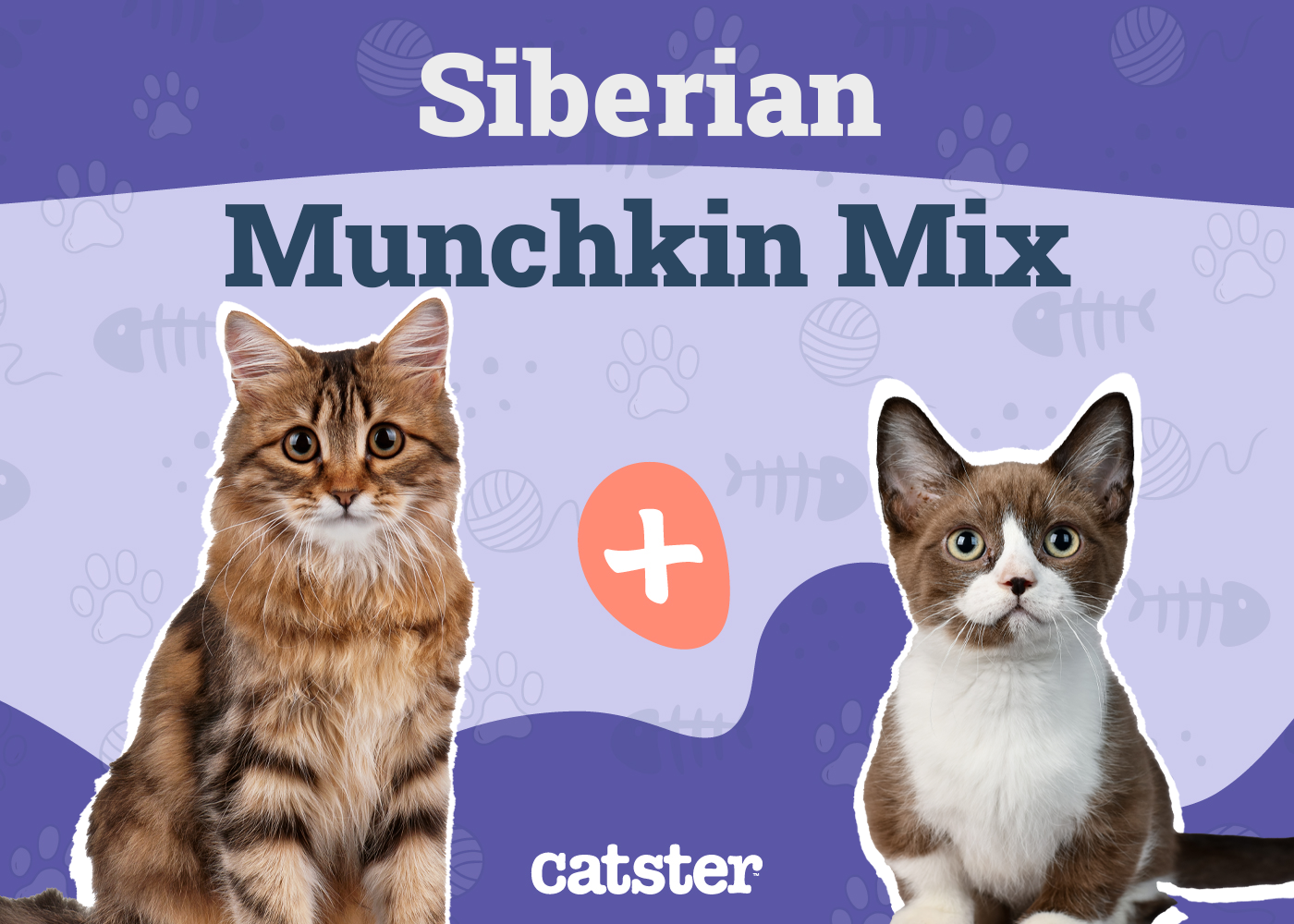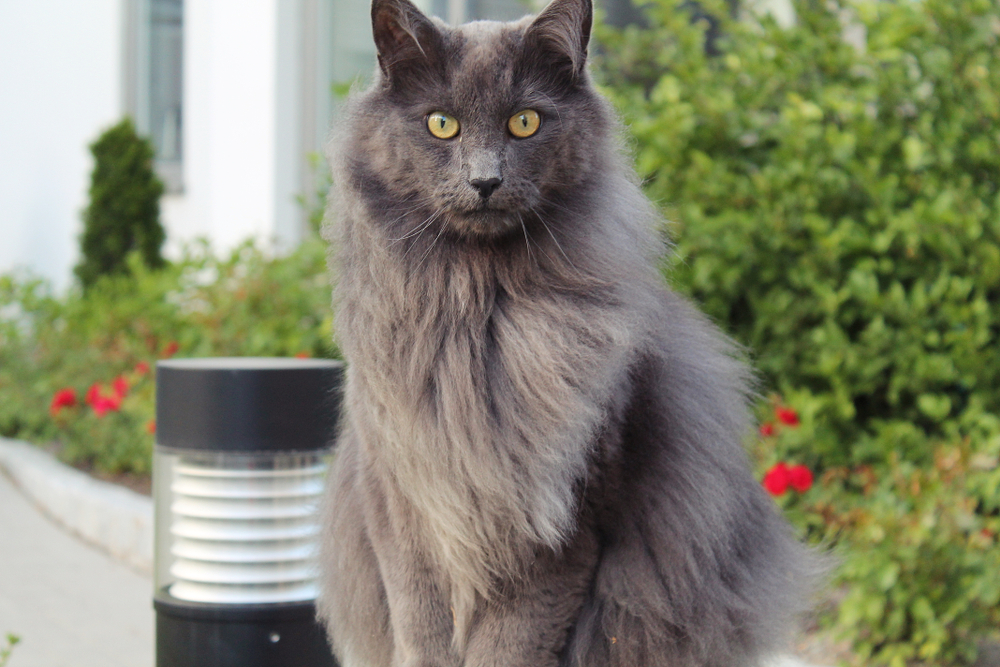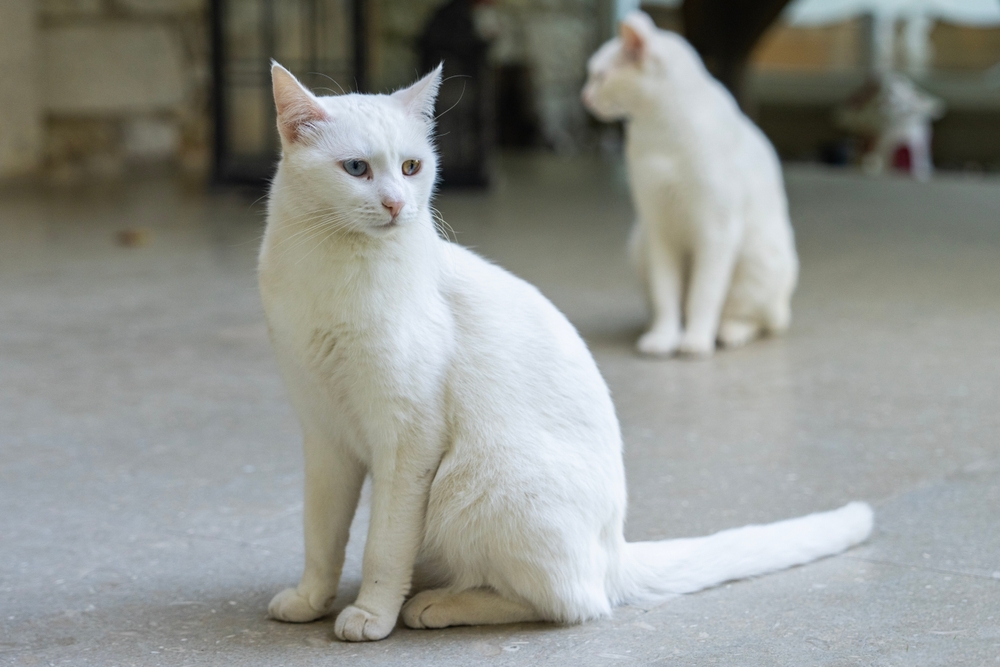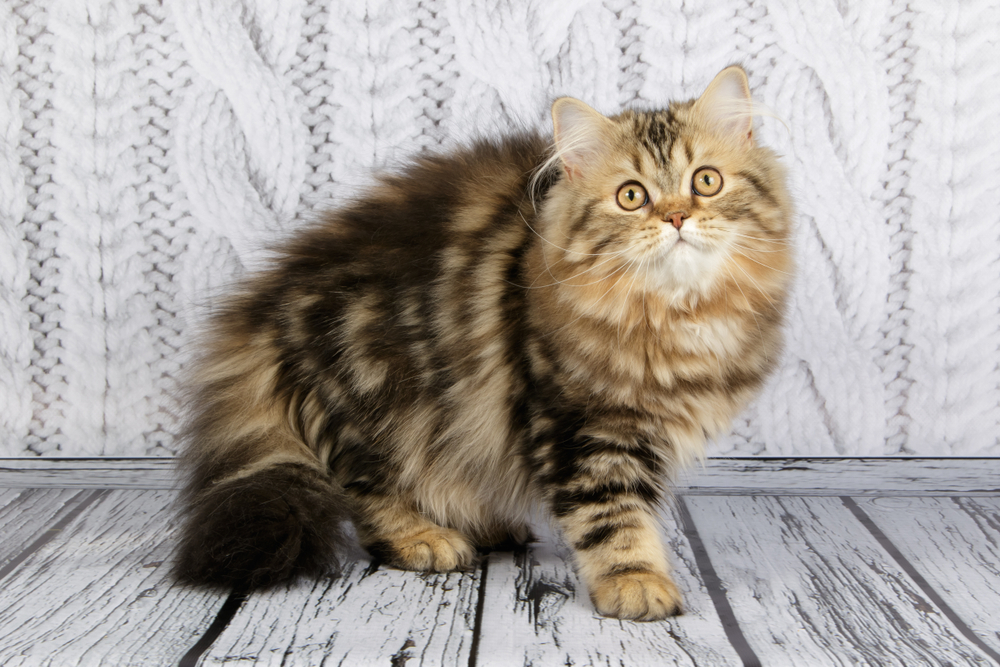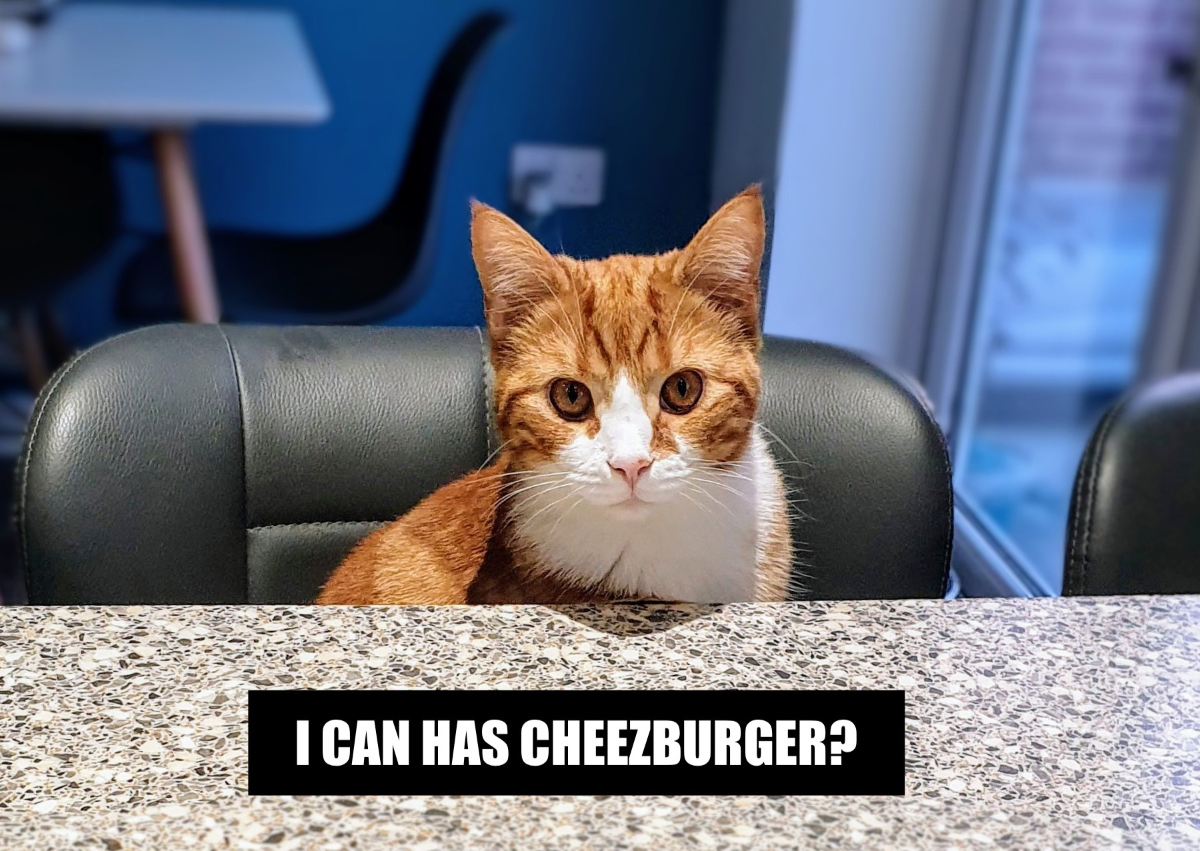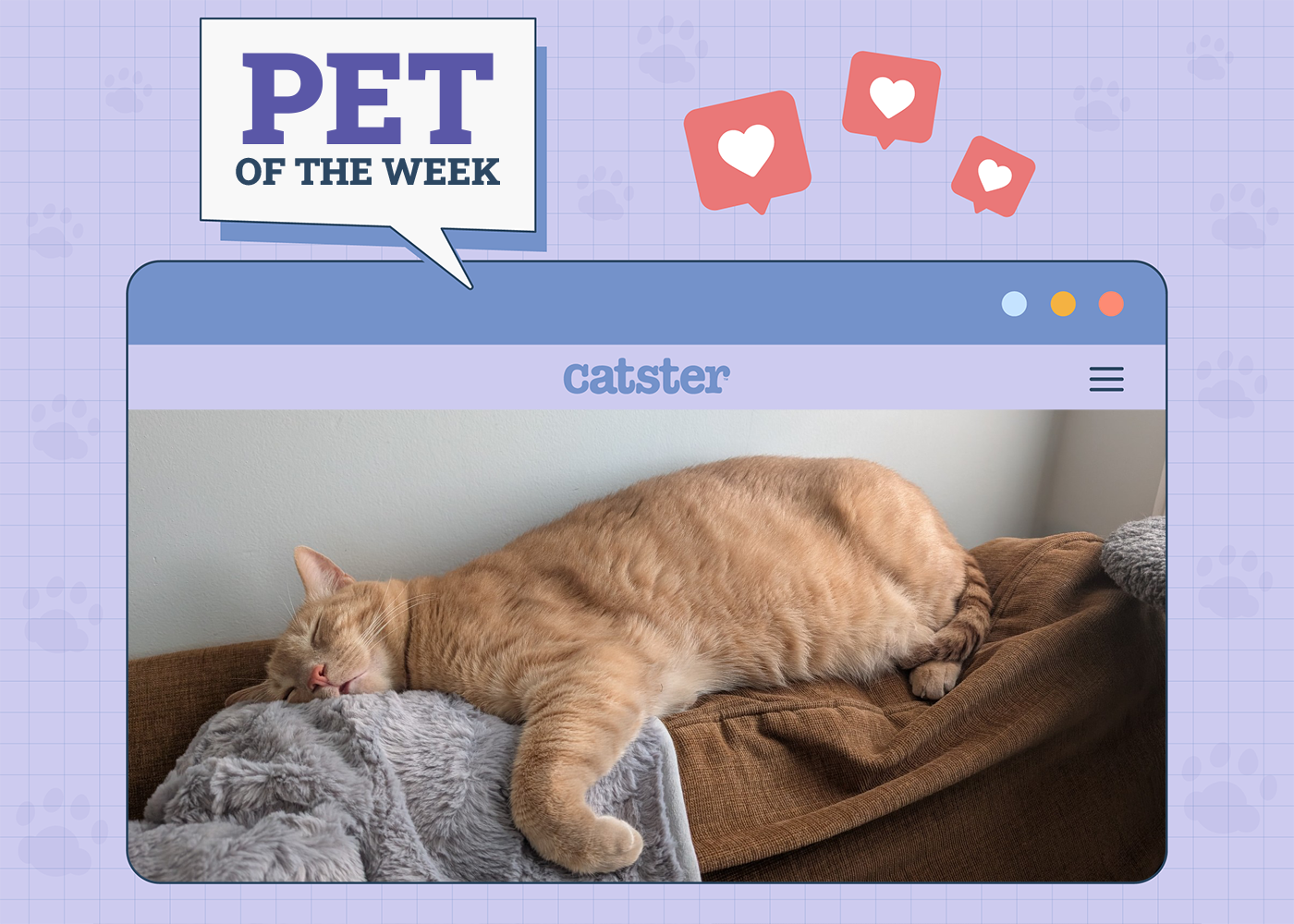Click Below to Skip Ahead
When most people imagine a Siberian–Munchkin mix, they probably think of a furry cat with tiny legs. However, this isn’t always going to be the case. Instead, as a mixed breed, these cats can look quite different. In fact, in most cases, only about 25% of a litter will have short legs. Not even all Munchkin cats have short legs.
Breed Overview
Height:
7–12 inches
Weight:
9–20 pounds
Lifespan:
10–18 years
Colors:
Varies widely
Suitable for:
Cat owners looking for a smaller, affectionate cat
Temperament:
Playful, sociable, affectionate
Furthermore, all the other traits will be up in the air, too. These cats may have long hair, but they may also have shorter hair. They could be either color of their parent. Their temperament will depend partially on the traits they inherit from their parents, as well.
Therefore, these cats tend to vary a lot. It all depends on the traits each kitten inherits from their parents, which is impossible to predict.
Siberian Munchkin Cats Characteristics

3 Little-Known Facts About the Siberian Munchkin Cats
1. They can be unhealthy.
Generally, most mixed breeds are healthier than either of their parents. This is what we call “hybrid vigor,” and it occurs because the kittens inherit a wider range of traits from their parents. In other words, they are less likely to inherit negative traits.
However, this isn’t necessarily the case with this breed. The same trait that leads to shorter legs directly causes several health problems. Therefore, mixed-breed cats with shorter legs will be at the same risk of these health problems as their Munchkin parents.
2. They’re quite rare.
Some mixed breeds have taken off in the last couple of years. However, this isn’t one of them. Munchkin cats are unhealthy, and there is much debate on whether they should even exist as a breed. Therefore, bringing their unhealthy traits into other breeds is frowned upon by many.
However, these cats can be popular with cat owners who don’t understand the health implications they bring. Therefore, some breeders still produce them.
3. The short-legged gene is dominant.
If a cat receives a single copy of the trait that causes these cats to have short legs, then they will have short legs. However, that doesn’t mean all mixed-breed kittens will have short legs. Usually, a munchkin cat only has one short-leg gene. Therefore, this gene will be inherited by about 25% of the kittens. If the cat has two genes, then about 50% of the litter will inherit it.
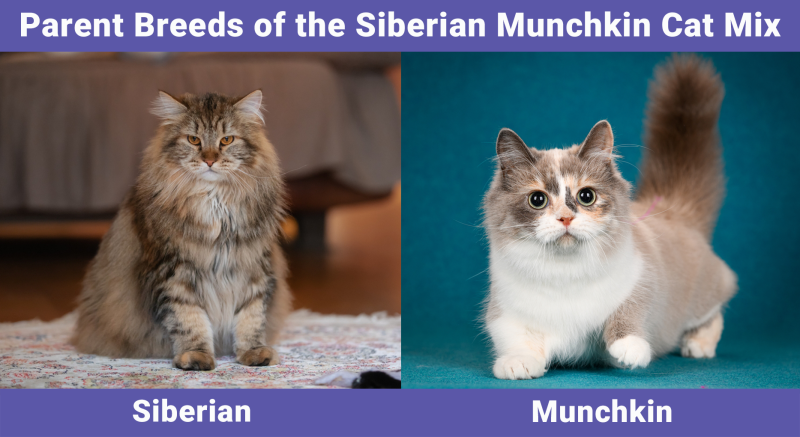

Temperament & Intelligence of the Siberian Munchkin Cat Mix
Determining the temperament of a mixed-breed cat can be challenging. Temperament is determined partially by genetics. However, when you’re mixing two different breeds, it depends a lot on what traits a particular kitten develops. Furthermore, the environment also changes a cat’s temperament, and cats from the same litter can act very differently from each other.
Usually, these cats are pretty outgoing. They are more confident than other cats, which makes them less likely to get scared. However, socialization is still required. Otherwise, these cats won’t be as outgoing as they could be.
Despite their (sometimes) shorter legs, these cats are often fairly playful. They can be energetic and may be more hyper than most cats. Therefore, having climbing structures and plenty of toys is helpful.
If training begins early, then these cats can be quite trainable. Of course, it does vary from cat to cat, with some being much more trainable than others. While the cat’s intelligence does matter, the cat’s orientation to humans matters more (usually). Cats aren’t made to take commands from humans like dogs are, which means they’re much less likely to listen to a command.
Most of these cats can be trained to walk on a leash, which is very helpful when you take their energy level into account.
Are These Cats Good for Families? 👪
This mixed breed can be good in families. Their outgoing attitude makes them perfect for larger families that often have visitors. Unlike some breeds, they’re unlikely to hide at the sound of the doorbell. However, socialization does matter. If you get your cat around lots of people when they’re younger, they’ll be more likely to accept strangers when they’re older.
All cats should be introduced to children as kittens—even if you don’t have children. Children act very differently from adults, which can be off-putting if a cat isn’t used to them. Therefore, introduce your cat to all types of people, including children.
These cats also work best for more active families. They can be affectionate, but they are also known for being quite active.
Does This Breed Get Along With Other Pets?
This breed can get along with other pets, but socialization is vital. They are often more outgoing and less likely to be fearful than other breeds. Still, this isn’t always the case. If a cat isn’t introduced to dogs at a young age, they will probably be fearful of dogs later.
Therefore, if you want your cat to be outgoing around other pets, get them around other pets as early as possible. Be sure to introduce them to many types of dogs, as well. Smaller dogs act and look very different from big dogs.
With that said, this breed will have hunting instincts like any other cat. Therefore, we don’t recommend having them around small pets that may look like prey animals. Mice, birds, and similar animals can quickly flip these instincts on—even if your cat seems okay initially.

Things to Know When Owning a Siberian Munchkin Cat Mix:
Food & Diet Requirements 🐡
These cats don’t need a special diet. However, a healthy diet is vital to help them maintain a healthy weight, especially if they have short legs. These cats tend to have joint problems, and extra weight only makes these worse. Plus, obesity can lead to a slew of other health issues, too—even if your cat has normal legs.
Therefore, one of the most important aspects of feeding this mixed breed is giving them the proper amount of food. Always follow the instructions on the bag. If your cat seems to gain weight even when the instructions are strictly followed, you may need to switch to diet food. You should not simply feed less regular food, which may lead to nutritional deficiencies.
Diet food is extra-dense to ensure that your cat consumes the proper nutrients while getting fewer calories.
Beyond that, get your cat a meat-based food that’s high-quality. Before getting a cat, be sure you have the budget for quality food. While cheaper foods are available, they usually aren’t the best for most cats.
Exercise 🐈
These cats often have plenty of energy, so getting them to exercise isn’t often a problem. Therefore, your job is to provide them with enough toys to help them exercise enough. Cats play in many ways, so having toys and play equipment that encourage these modes is vital.
Firstly, cats will “hunt” as part of their play. Most cat toys are aimed at this type of play, and it’s the type most people recognize. However, others do exist.
For instance, climbing is a type of play for cats. Therefore, we recommend investing in a proper climbing structure. Multiple climbing structures may be better than one large one, especially if you have a larger home.
Hiding and pouncing is a form of play. Traditional toys can help encourage this play, but many cats may attack our feet, as well. Scratching is another form of play. There are many scratching posts and other pieces of equipment available. We recommend having multiple scratching options in different positions around your home.
Training 🧶
These cats can be very trainable. If you find your cat in this category, training them regularly can be helpful. It helps keep your feline mentally stimulated and can make living with them a bit easier, too.
However, at the very least, we recommend getting these cats used to a crate for transportation. This training makes transporting them to the vet much easier. Plus, it can lower the stress they feel while transported, which can be very helpful when they’re sick. (The last thing you want to do is stress out a sick cat.)
We also recommend leash-training your cat if possible. These cats can be very active, and going on walks can be very helpful in helping them get some energy out. Therefore, it’s a useful skill if your cat takes to it. (Cats usually take longer to leash-train than a dog, so be prepared for months of work.)
Grooming ✂️
These cats don’t require significant amounts of grooming. If they have longer hair, they may require occasional brushing. Once a week is often suitable unless your cat seems particularly prone to tangles. However, beyond that, they are fairly good at keeping themselves clean.
When the seasons change, you may need to brush extra to handle extra shedding. However, this mostly depends on your cat and the climate.
If they have shorter legs, we recommend having some cat-friendly wipes on standby. Their shorter legs can make it more challenging to reach certain places on their body for cleaning. Therefore, having some wipes to provide assistance is always helpful, though not all cats with shorter legs have this problem.
Health Conditions 🏥
- Spinal issues
- Uremia
- Hyperthyroidism
- Osteoarthritis
- Pectus excavatum
If your mixed-breed cat doesn’t have short legs, it will likely be very healthy. These felines are less likely to inherit negative health traits from either parent since their parents are unlikely to share any health problems. Therefore, they tend to be healthier overall than either parent breed. Plus, Siberian cats are landrace cats, which means they evolved naturally, and they tend to be extremely healthy.
However, cats with short legs will be prone to osteoarthritis. The same gene that makes these cats have shorter legs also damages their joints. Therefore, all cats with shorter legs will have joint issues—it comes with the territory. This condition has made these cats a bit controversial, as many pet advocates do not believe they should be bred at all.
If you adopt a cat with short legs, be prepared to handle joint problems. These issues require continuous treatment and can strike relatively early, leading to high vet bills. These cats are often more expensive to insure due to their poor health, as well.

Male vs. Female
This breed varies widely across different individuals. Therefore, it is not nearly standardized enough for differences to appear between sexes. These cats are affected more by what specific traits they inherit than by their sex.
Of course, usual sex differences will still exist. Female cats will go in heat, for instance. Spaying or neutering your cat resolves many of these issues.

Final Thoughts
Siberian Munchkin mixed cats can vary in how they look by a lot. These cats can inherit any trait from either parent, making them difficult to pin down. Only 25% of these felines will have short legs, for instance. They may have either short or fluffy hair, depending on their parents, and the picture of the cute, short, fluffy cat most people have in their heads may not be what they get in reality.
Of course, before you purchase one of these cats, you should be aware of their potential for health problems. All cats with short legs will have joint issues just about. Therefore, those with shorter legs often have higher vet bills.
Featured Image Credit: Left – claudia125, Pixabay; Right – SV_zt, Shutterstock

